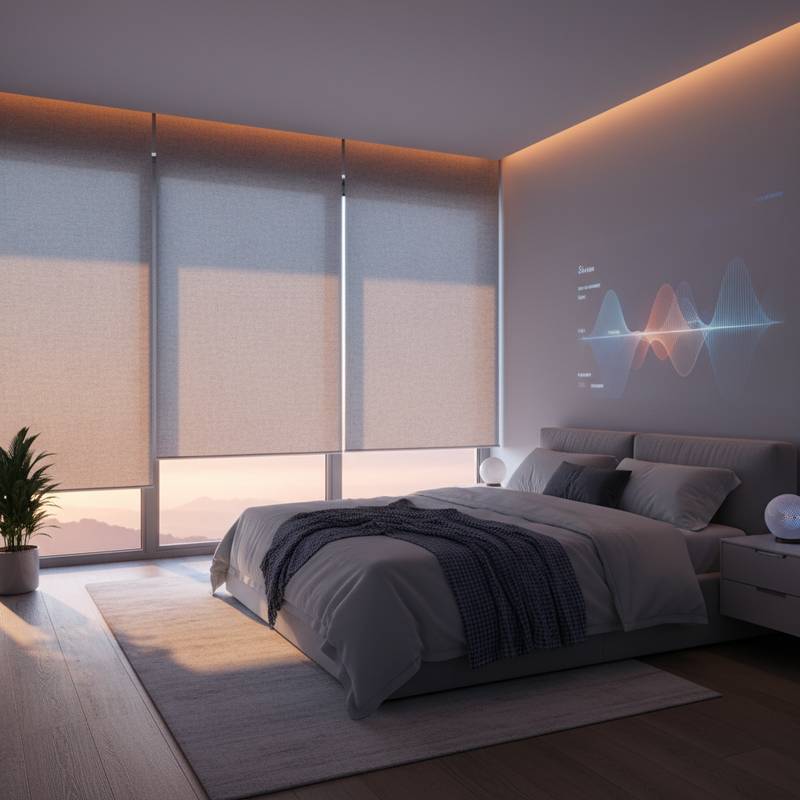Auto-Adjusting Smart Blinds for Ideal Sleep Cycles
Smart homes evolve from conveniences to essentials, and auto-adjusting smart blinds represent a key advancement in bedroom technology. These devices move beyond basic window coverings to actively support sleep quality, light management, and daily rhythms. With sleek designs and silent operation, they integrate sensors and algorithms to align with personal circadian patterns, enabling natural wake-ups and restorative rest.
Why Light Plays a Bigger Role in Sleep Than You Think
Circadian rhythms govern bodily functions through 24-hour cycles influenced by light, temperature, and habits. Exposure to morning light boosts cortisol production for alertness, while evening dimness promotes melatonin release for sleep. Disruptions from artificial sources, such as screens or urban glow, often throw these cycles off balance.
Automated blinds address this by precisely modulating natural light, acting as a wellness aid. They restore hormonal equilibrium and enhance rest without user intervention, turning passive windows into active health supporters.
The Science Behind Auto-Adjusting Smart Blinds
These blinds employ light sensors, predictive algorithms, and home network integration. Sensors detect ambient brightness, and software determines ideal positions based on time and weather data. Advanced units pull sunrise and sunset information to synchronize adjustments seamlessly.
Unlike fixed timers, they respond in real time: widening on overcast mornings for extra light or angling to block afternoon sun. This adaptability fosters a stable environment that aids concentration, reduces energy consumption, and promotes steady sleep patterns.
Trend 1: Circadian Lighting Integration
What it is: Blinds that pair with circadian lighting setups to replicate outdoor light variations inside.
Why it matters: Steady light patterns regulate energy, mood, and sleep. When blinds link with bulbs or fixtures, they create gradual shifts from energizing dawn hues to calming dusk tones.
Example: Lutron and Somfy models interface with Philips Hue systems. At dawn, blinds lift slowly as lights warm, easing you awake. By night, they lower as illumination softens, priming the body for sleep.
Trend 2: Adaptive Climate and Energy Efficiency
What it is: Blinds that adjust for temperature, sun strength, and room use to regulate climate.
Why it matters: Light control shapes sleep while cutting utility bills. They trap winter heat or shield against summer rays, ensuring steady comfort.
Example: Hunter Douglas integrates with thermostats and sensors. If heat builds, blinds descend to cool the space, optimizing rest and lowering HVAC demands.
Trend 3: Voice and App-Based Personalization
What it is: Blinds that adapt to user habits via voice controls or mobile apps.
Why it matters: Tailored settings make technology intuitive. They accommodate preferences like gradual mornings or pitch-black nights.
Example: With Alexa or Google Home, say "Good morning" for a soft open, or "Bedtime" for full closure. Machine learning refines these over time for effortless customization.
Trend 4: Sleep Optimization through Data Insights
What it is: Blinds linked to trackers or health apps that refine adjustments from sleep data.
Why it matters: Insights enable targeted tweaks. Poor sleep nights prompt changes in timing or intensity to rebuild routines.
Example: Sleep Number and Withings partnerships adjust blinds per reports. Early wakings trigger delayed openings, prolonging valuable rest.
Trend 5: Privacy and Security Integration
What it is: Blinds that work with security features for added protection and seclusion.
Why it matters: They simulate occupancy during absences, enhancing safety. Night routines pair with lights for comprehensive coverage.
Example: Control4 or SmartThings syncs blinds to sensors. Departure closes them; evenings align with perimeter alerts for reliable defense.
Trend 6: Sustainability and Eco-Friendly Materials
What it is: Blinds crafted from recycled materials with efficient, low-power mechanisms.
Why it matters: Green choices align with eco-goals. They minimize energy draw and use sunlight for operation.
Example: Solar-charging options harness windows for power. UV-blocking fabrics protect interiors and ease cooling loads.
The Daily Experience: How Smart Blinds Transform Your Routine
Picture mornings with gentle light matching your schedule, free of jolts. Blinds adjust through the day for tasks or downtime, then seal the evening calm. This rhythm cuts manual adjustments, trims power use, and eases sleep challenges like travel fatigue.
Overcoming Adoption Barriers
Complexity and expense deter some, but solutions simplify setup. Wi-Fi direct connections skip hubs, and batteries avoid wiring. Apps guide easy configuration.
Prices fall with market growth, matching basic motorized options. Wellness and savings justify the outlay, delivering ongoing returns.
The Broader Shift Toward Light Wellness
Smart blinds advance light wellness, where tech bolsters biology. Research links regular light to better mood, output, and rest. These tools automate benefits for busy lives.
They elevate everyday shades to wellness partners, blending nature with innovation.
Integrating Smart Blinds into Your Space
Target your bedroom first, where light impacts rest most. Select motorized units with timers or dawn modes. Link to lights or trackers for deeper sync.
Choose compatible brands for your hub, like Alexa or HomeKit. Opt for hybrid controls blending auto and manual. Factor in eco-features for lasting appeal.
These systems bridge automation and health, shaping homes for vitality.
